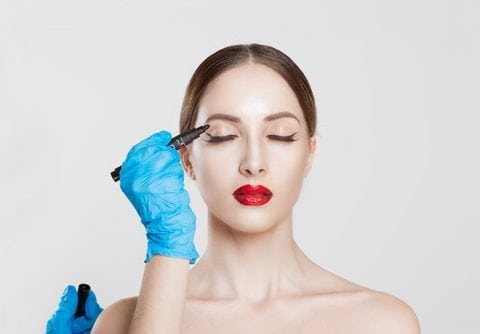Three Things to Know about Upper Eyelid Lift
Our eyes are the most captivating part of our face. They are windows into our emotions, and an old saying would attest they are windows into our souls. But it’s not just an ancient saying. Scientists have discovered that the iris may also reveal our character and psyche. Eyes are also a key determinant of beauty. One only needs to look at beautiful women and handsome men and notice they have gorgeous eyes. As we age, unfortunately, the upper eyelid starts to hood over our eyes. Not only does this create a tired look, but it can detract from one’s appearance. Many women complain they can’t put makeup like they used to.
It’s no surprise that upper eyelid lift (or upper blepharoplasty) is one of the top requested cosmetic surgeries in the U.S. Unlike other aging problems, this is one problem that surgery really is the best option. Fillers and Botox can’t reduce the excess upper eyelid skin. If you are contemplating having an upper blepharoplasty, there are three things you should keep in mind.
First, make sure you see a board certified surgeon with experience in upper blepharoplasties. Facial plastic surgeons, plastic surgeons, and oculoplastic surgeons are all well trained to perform these procedures. At your consultation, the surgeon will get a good history and perform a detailed physical. The exam is critical to make sure you don’t have lid ptosis—or where the eyelid is actually weak and hangs down over your pupil. A standard blepharoplasty will not solve this problem. In my opinion, these problems are best treated by oculoplastic surgeons. However, if you don’t have ptosis, then the exam will help the surgeon determine how much excess skin you have. Another important part of the exam is to evaluate the position of your brows. If your brows are low, they can exacerbate the problem. Sometimes, just doing an upper blepharoplasty without raising the brows will not solve your problem. Some patients should also get a brow lift to get the best results.
Second, upper blepharoplasties are very straightforward procedures, but must be performed carefully, with attention to detail. Many patients can safely be operated on in a surgeon’s procedure room with just local anesthesia. Oral sedation or IV sedation may be used if the patient prefers. The procedure entails carefully measuring the amount of skin to be removed. This can be done by marking out the amount of skin before incision, or can be accurately performed by a technique similar to a facelift. Once the excess skin is removed, it’s critical that there is no bleeding. Some patients may need some extra fat under the septum to be removed. The wound is then closed very precisely. As mentioned before, the surgery is very safe, but anytime one is operating on the eye, the surgery must be performed very carefully. Thorough knowledge of eye anatomy is mandatory to perform this surgery safely. Complications that can occur after blepharoplasties include bleeding, infection, scarring, and possible milia (trapped skin cells under wound). These can happen even to experienced surgeons but can usually be fixed. More severe and very rare complications include eye injury, double vision, blindness, and the inability to close the eye due to too much skin removed. These complications are exceedingly rare if one is experienced. They may be unacceptably high if an inexperienced surgeon or doctor performs the surgery.
Third, proper wound care is very important to a good result. Most importantly, you need to keep the eyes moist. Even a properly performed blepharoplasty will result in swelling and temporary gap when you close your eyes. The biggest threat is excessive eye dryness that—if not treated—can cause major eye damage and even blindness. Your surgeon will prescribe eye drops that you should use very hour while awake. Often, an eye ointment under your eyelid will be used before you go to bed. You should also avoid watching too much TV or reading since these will cause your eyes to dry out. It’s normal for the wound to ooze the first few days. To help the wound heal better and make suture removal easier, it’s important to clean the scabs with hydrogen peroxide and then immediately cover with eye antibiotic ointment. After surgery, you should refrain from any strenuous activity for about two weeks because this may increase your risk of bleeding. The incision should be well healed by one month, but will take many months to really look good. It’s very important you keep your follow up schedule with your surgeon.
For more information about upper eyelid lift in San Antonio contact Dr. Kenneth Yu Facial Plastic and Reconstructive Surgery. We are a qualified team of experts serving the San Antonio, Texas area. To schedule a consultation, please call our Concierge Patient Coordinator at (210) 876-6868 today.


